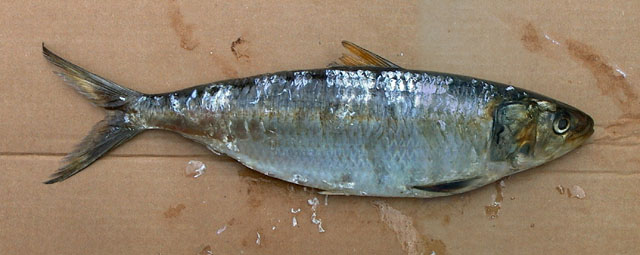| Clupeidae (Herrings, shads, sardines, menhadens), subfamily: Dorosomatinae |
| 30 cm TL (male/unsexed); max.weight: 229.0 g; max. reported age: 7 years |
|
reef-associated; depth range 0 - 350 m, oceanodromous |
| Atlantic Ocean: West African coast from Gibraltar southward to Saldanha Bay in South Africa (Ref. 188, 81269, 81631); also in Mediterranean Sea (Ref. 188, 81631) and Black Sea (Ref. 188). In western Atlantic Ocean from Cape Cod in USA to Argentina (Ref. 188), including Bahamas, Antilles, Gulf of Mexico and the Caribbean coast (Ref. 26938). |
|
Dorsal spines (total): 0-0; Dorsal soft rays (total): 13-21; Anal spines: 0-0; Anal soft rays: 12-23. Diagnosis: Body elongate, usually subcylindrical, but sometimes a little compressed; belly rather rounded, but scutes apparent (Ref. 188, 81269). Lower gillrakers fine and numerous, more than 80; anterior gillrakers on lower limbs of second and third gill arches lying more or less flat (Ref. 188). The pelvic finray count of 1 unbranched and 8 branched rays distinguishes Sardinella aurita from all other species of Sardinella, Harengula, Opisthonema, Herklotsichthys and Amblygaster that occur with it (Ref. 188). It resembles Clupea but it has two fleshy outgrowths along outer margin of gill opening and numerous fine fronto-parietal striae on top of head (Ref. 188). Flanks silvery, with a faint golden midlateral line, preceded by a faint golden spot behind gill opening; a distinct black spot at hind border of gill cover (Ref. 188, 3259).
Description: Body elongate, subcylindrical, sometimes rather compressed; belly more or less rounded (Ref. 188, 81269, 81631). Lower limb of first gill arch with 130-248 gillrakers (Ref. 81269). Dorsal fin with 17-19 rays; anal fin with 17-21 rays; pelvic fin with 9 rays (Ref. 81269, 81631). Scales cycloid: 42-47 in a longitudinal series to caudal-fin base; 17-19 prepelvic and 14-16 postpelvic mid-ventral scutes (Ref. 81269, 81631).
Colouration: Back bluish gray, sometimes greenish; sides silvery to brassy, without spots or streaks (Ref. 7251). In alcohol-preserved specimens, sides silvery, with a golden lateral band; there is a black spot on hind margin of operculum (Ref. 81269, 81631). |
| Schools in coastal waters from inshore to edge of shelf. Prefers clear saline water with a minimum temperature below 24°C. Juveniles tend to stay in nursery areas, but on maturity rejoin adult stocks offshore. Strongly migratory, often rising to surface at night and dispersing. Feeds mainly on zooplankton, especially copepods. Juveniles take phytoplankton (Ref. 27121). Breeds perhaps throughout the year, but with distinct peaks. In some areas there are two main spawning periods. Marketed fresh or canned (Ref. 188). Trematode found in intestinal tract (Ref. 37032). |
|
(Ref. 96402)
|
| harmless |
|
Source and more info: www.fishbase.org. For personal, classroom, and other internal use only. Not for publication.
Page created by Jen, 05.08.02,
php script by kbanasihan 06/09/2010 ,
last modified by
dsantos, 20/08/10

